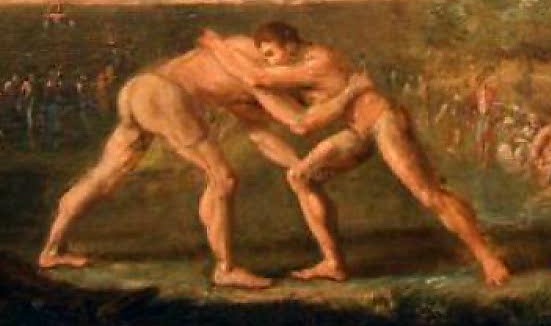- Name of sport (game): Lucha Leónesa
- Name in native language: Lucha Leónesa
- Place of practice (continent, state, nation):
Spain (León)
- Description:
Lucha Leonesa is played on grass, outdoor, during the summer festivals, and on mats during the winter season.It is a standing up wrestling style with clothes.
The wrestlers (men or women) wear a T-Shirt and a short. Legs can grip legs. The arm position is fixed with hands gripping in a tight leather belt. Several weight and age categories.
Techniques are mainly with hips and legs.
To throw the opponent on the back give 2 points. The victory is given when a wrestler gets 4 points.
- Name of sport (game): Lutte Provençales
- Name in native language: Lutte Provençales
- Place of practice (continent, state, nation):
South of France
- History:
The region of Midi (Southern France) a stronghold of French Huguenots was also a prominent center of Lutte Provencales (Folk Wrestling Style of Provence). The region of Provence was part of Frankish Kingdoms (at first Merovingian, then Carolingian) since the VI century. The Franks were people with Germanic origins who around 800 under the rule of Charlemagne (742-814) established the Carolingian Empire in Europe. That Empire later split into two kingdoms, East Francia and West Francia, the former became known as the Kingdom of Germany and the latter was known as the Kingdom of France. Notably, the best Graeco-Roman wrestlers came from those two countries. Flemish and Dutch people were both descendants of Franks as well.
The folk wrestling style of the residents of Provence was after the old Frankish wrestling fashion. The core of all wrestling styles of Frankish origin was a combination of catch-holds and ground wrestling. Another important detail was that just like in modern professional wrestling the “lift and throw” technique played decisive role, and the use of legs and feet for throwing (hooking and tripping techniques) was insignificant in that particular style. Among the most famous practitioners of Frankish wrestling was fearless warrior Henry I, Duke of Guise (1550-1588) of Carolingian ancestry, who sometimes was called Le Balafré (Scarface).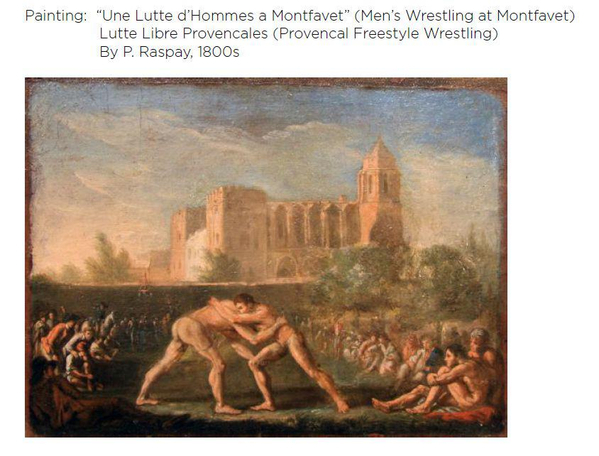
The Frankish wrestling traditions were inherited by French and German people. Simon Goulart (1543-1628) the Medieval French humanist speaks of the contemporary French and German wrestling customs in “Lichamelicke Sterckte” (Physical Strength) a chapter from his 1625 book called “Cabinet Der Historien.“ He mentioned a certain wrestling style called “Worstelen (Worstelinge), Lijf tegen Lijf”, or “La Lutte, Corps-à-Corps” which means “Wrestling, Body to Body” (Scuffle).
In this style the wrestlers started their match at a distance from each other and quickly would get into close quarters and after that proceeded as they wanted. The conditions of the match were previously negotiated by the combatants. Often to take opponent down wasn’t enough in that style, the winner had to force his adversary on his back and keep him underneath thus making him quit any resistance and verbally admit his defeat.
In France this hand-to-hand combat was known as the Burgundian wrestling (Lutte Bourguignonne). Historically, Burgundian wrestling was represented by two styles: Bras-le-Corps (equal catch-hold around the torso/waist) and Corps-à-Corps (free-for-all close wrestling combat which usually started with head-holds). The former style was a standing wrestling for a throw (back fall) and the latter was an up and down wrestling in which the objection was to overcome your opponent on the ground.
The “lift and throw” technique dominated those two styles and better developed muscles of the hip, groin and lower abdomen areas were a decisive factor. Often competitors would try to achieve a Bear Hug or a Crotch Hold on their opponent, lift him off his feet in the air, lock arms around his body and cast him down on the ground. Such Bodyslams were known as the “stones from the sky” throws (meteorite throws). Notably, use of legs and feet for throwing wasn’t favored in either of those styles, since only wrestling with hands, arms, hips and back was considered a true trial of strength and skill.
The great visualizations of those two modes of wrestling are present in the form of Romanesque sculpture at Burgundian churches, such as Church of Our Lady of the Assumption at Anzy-le-Duc (XI-XII c.) and Church of St Peter at Saint-Pierre-le-Moûtier (XII-XIII c.). Depictions of both those wrestling styles also could be found in a XIII c. Sketchbook by the architect called Villard de Honnecourt. His name and dialect indicate that he was born in Honnecourt, a small town near Cambrai in northeastern Picardy at the frontiers of Artois and Flanders.
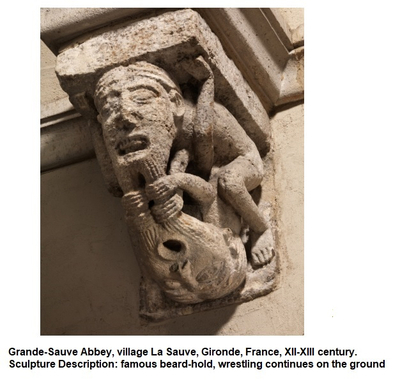
William Caxton (1422-1491) an English writer, in his translation of French prose romance "Les Quatre Filz Aymon" mentioned 2 starts in Frankish folk wrestling, “at a distance” and “close equal hug.”
Notably, the Frankish up and down catch wrestling French terminology is still in use by the practitioners of the traditional folk freestyle wrestling of the natives and residents of the Reunion Island (a French department in the Indian Ocean). That culturally unique historical wrestling style called the La Croche takes its name from the old French wrestling term a verb Se Crocher which means to catch someone, to lay advantageous hold of someone. This style is dominated by three wrestling strategies:
1) the Caler (drop, fall) a variety of take down holds and techniques used for throwing someone down from the standing position;
2) the Clef (spanner, wrench) a different limbs twisting techniques which are used in order either to cause a fall from a standing position or to roll opponent on his back when on the ground;
and
3) the Trappeur (trapper) a number of ground wrestling techniques which allow “to trap” opponent and keep him immovable underneath in a locked position thus making him quit any resistance and acknowledge his defeat which signifies a victory in this sport.
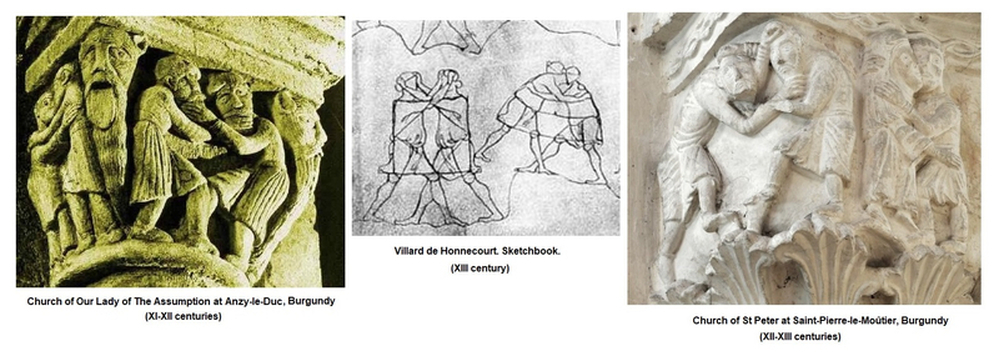
- Description:
Probably the most descriptive accounts of historical Provencal folk wrestling were provided by Henri Rolland in his short story called “The Wrestler” from the 1st volume of "Les français peints par eux-mêmes : encyclopédie morale du dix-neuvième siècle" (1841) and in the article by Jean Brunet from the 1882 book called “Revue Des Langues Romanes.”
Various wrestling games were once in strong favor among the men of Provence. The wrestling challenge matches and elimination tournaments played an essential part in celebrations at all the folk and religious holidays called the Roumavage.
Based on the traditional Provencal classification of wrestlers as per their strength there were two championship classes of local wrestlers:
1. Men’s Wrestling (Lucho dis ome) was a competition of really strong men and exceptionally strong men.
2. Half-men’s Wrestling (Lucho de miechome) was a competition of moderately strong men, young adults and youth.
There were two distinctive styles of Provencal folk wrestling:
1. Lucho de la centuro (en aut), lutte de la ceinture en haut, which was a standing catch-hold above the waist wrestling style. In this style holds of any part of the body from head to the waist including dangerous headlocks (holds around the neck) were allowed. In this style only the use of hands, arms, hips (hip lift technique) and back for throwing was legal. The objective of this wrestling style was to give the opponent a fair back fall (two shoulders touching ground simultaneously). In this wrestling style all throws were the flying falls. Often if a man was thrown on his back three times without fair back fall taking place (3 foils rule) he was declared defeated. In case of both wrestlers falling to the ground without the back fall or foil being achieved (dog fall) they had to get up quickly and renew the contest.
2. Lucho Libro, Lutte Libre, which was a freestyle wrestling. That style of wrestling was also known under the following names: lucha a touto lucha (lutter a toute lutte) or all-in wrestling, and lucha en arrapant pertout (lutter en attrapant partout) or catch-as-catch-can. In this style of wrestling holds of any part of person’s body and ground wrestling (lutto a terro) were allowed. Technically any fair method of throwing was considered legal. If both wrestlers fell down to the ground they will have to continue their struggle on the ground until one of the two is finally placed flat on his back and kept immovable (captured) in the undermost position until he gives in and admits his defeat verbally.Tripping (Croc-en-jambe) was strictly prohibited in Lutte de la ceinture en haut and technically being allowed in Lutte Libre still wasn’t favored. This was based on a local stereotype of tripping being sort of an unfair action. According to their traditions tripping was thought of as a wrestling technique that didn’t exhibit strength or skill, as they felt that true wrestling was only with hands, arms, hips and back. Interestingly, a similar stereotype dominated German wrestling customs as well. Often participants of the Men’s Wrestling championships would prefer to compete in the standing wrestling above the waist style. Their logic was based on the popular opinion that a really strong man doesn’t need holds below the waist, ground wrestling, or tripping to throw his opponent off his feet and give him a back fall or at least a foil.
But if wrestlers decided to compete on “free for all” conditions then back fall wasn’t enough to win the contest and the winner had to make his opponent quit the struggle and verbally confess his defeat.
Punching, kicking and any other unlawful or brutal act was strictly prohibited.
In the ring wrestlers appeared stripped to the waist. Traditionally, the winners of the competitions were awarded various trophies, such as silver cups, embroidered velvet underpants fringed with gold or silver, etc. Over the time professionalism was introduced in Lutte Provencales.
Sometimes the lutte libre pro wrestling matches would turn into an all-in, rough and tumble combats of wrestling and fighting combined. In those no holds barred affairs some non-wrestlng strategies like punching with the fist and kicking were a common practice.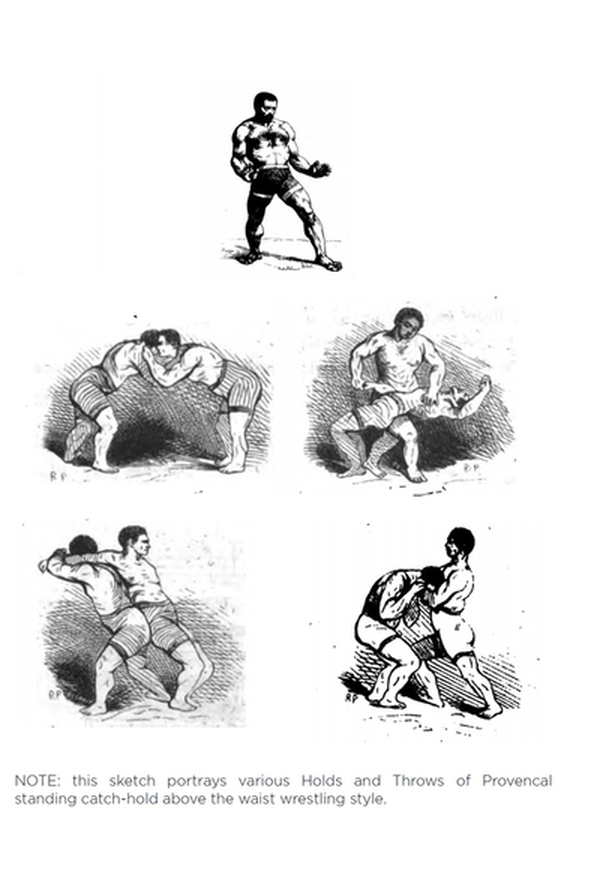
- Current status:
Currently Lutte Provencales is not practiced anymore. In France the folk wrestling styles of the residents of Provence were still around even in the 1860s until they were completely replaced with the modern French or Graeco-Roman style, which back then was also known as a “flat hand” wrestling (la lutte à main plates).
Many of the “Protestant weavers” who fled from religious persecution, migrating from Southern France to Britain in XVI-XVII centuries found their new home in East Lancashire and West Yorkshire. The waves of Flemish, German and French Protestants brought old Frankish freestyle wrestling to East Lancashire where it merged with folk English catch-hold wrestling
style and over the course of centuries it evolved there into a new unique style of wrestling the Lancashire Catch-as-catch-can. Meanwhile, on the continent, Frankish style evolved into the French wrestling, aka Graeco-Roman wrestling. Interestingly, even in the 1870s when the French style was widely exhibited in England, the most common commentary on it was that in its nature, French wrestling is very similar to Lancashire catch wrestling. - Sources of information :
Ruslan C Pashayev, The Story of Catch, 2019
- Name of sport (game): Matkot
- Name in native language: מטקות
- Place of practice (continent, state, nation):
Israel
- Sources of information :
Video:
https://www.youtube.com/watch?v=xVyNq9qAihY
https://www.youtube.com/watch?v=N9VMEj4K9Xc
https://www.youtube.com/watch?v=3TakvSztkgc
- Name of sport (game): Mundje vençe
- Place of practice (continent, state, nation):
Albania
- Name of sport (game): Nabast
- Place of practice (continent, state, nation):
Bulgaria
- Name of sport (game): Palant
- Name in native language: Palant
- Place of practice (continent, state, nation):
Poland – one of the most interesting places where its traditions have been preserved, in an interesting local form, is Grabów near Łęczyca (Łódź Province), where there is a special feast, called “Palant Feast”, organized every year; other places: Cyprzanów, Warsaw, Cracow, Rzeszów, Gdansk, Słubice (Polish Champion in palant with trainings every week), in the past also Lublin, and other places, also abroad – the number of places is constantly increasing, thanks to the development and promotion of Palant by Polish Palant Association.
- History:
The word “palant” is derived from the Italian word pallante and since the Middle Ages it meant
“a ball player”.
The sources of the game of Palant in Poland date back to the Middle Ages. Over the centuries, it has developed not only in Poland, constituting an interesting, physical, team form of playing with the use of a ball and a stick.
According to some historical sources, Palant had a significant influence on the development of American baseball. Polish emigrants were supposed to bring it to America at the beginning of the 17th century. In the centuries that followed, the game and its many variations continued to evolve around the world.
In the 20th century, Palant was still popular in Poland. Especially in Silesia, where regular competitions were held. There was even a Palant league, this sport was practiced in schools and serious works were written about it.
After the second world war, even the Polish championships began to be organized, and in 1957 the Polish Palant Ball Association was established. In the 1960s, a doctoral thesis was written on the forms of playing Palant in Poland, presenting a very high scientific level. Its author was Zofia Dowgird.
However, after these events, Palant started to be criticised. Some representatives of the press and academic circles were considering Palant as a secondary topic – not worthy to be treated seriously. Communist authorities were also trying to destroy traditional Polish culture. In many other countries, in which there are similar sports, this would be unthinkable.
As a result of this criticism, Palant began to lose its importance in Poland. The Polish Palant Ball Association was changed to Polish Baseball and Softball Association. Urbanization and industrialization, and consequently, fewer and fewer natural squares for playing Palant, led to the fact that this Polish sport with a centuries-old tradition began to disappear, and the word “palant” acquired a negative meaning (literally translating: “a jerk”). Such a situation in the United States or England would be difficult to imagine. In 2014, Polish Palant Association was created with the mission of reinventing Palant (it is described in more details below). There are also plans to create International Federation of Palant soon. - Description:
The basics:
Palant is a sport from a big family of “bat and ball games”.
The basic aim is to hit the ball with a wooden stick (around 60 cm long), called a palant or a palestra, into the field, and then to run to the next “bases” as soon as possible. The task of the hitting player is to run all the four bases and come back to the first base, called “the nest” (in Palant it is called “zapłot”).
At the same time, the players of the opposing team try to catch the hit ball and hit the running rival with it. If he/she is hit between bases, this player is eliminated from this round. If the player is hit between bases, he/she is also eliminated. Three such situations cause the change of sides between teams.
If the ball hits the “hell” (piekło) square, play continues until either the player is knocked between bases or it is thrown over the starting line towards “hell”, then play is stopped and if the player has not reached the next base, he returns to the previous base. The defenders can pass the ball between themselves, while the attacker cannot deliberately touch the ball in play - if he/she does it intentionally, there is an automatic change of sides.
Attacking players can't run out of “hell” zone either - then there would also be a change of sides.
The pitch is 20 meters wide x 50-60 meters long. You need to draw there the bases for two different zones: “Niebo” (eng. “Heaven”) and “Piekło” (eng. “Hell”).
There is a no time-restriction game. A match is divided into 1 to 7 Rounds (with 2 to 14 changes of sides).Their number is determined by the agreement (level, type of match etc.). Normally, during the tournaments, there are 2 rounds: each team hits the ball twice.The players:
Participants are divided into two teams of 7 to 15 players. The optimal number for one team is 8 players and there are such teams playing during the tournaments. The games are played with mixed teams (girls + boys) – a minimum of two girls in one team (since 2024, there will be a minimum of three girls required).
The basic course of the game (one run):
1 Game – one team hits the ball with the bat, the other team defends by catching the balls and trying to hit the opponents or to throw the ball to the base no. 1 before the attackers reach the bases number 2-4 (they can also kick the ball, trying to reach the base no. 1).
2 Change – the teams change sides and roles.
The pitch:
The pitch is divided into Bases (see the chart below):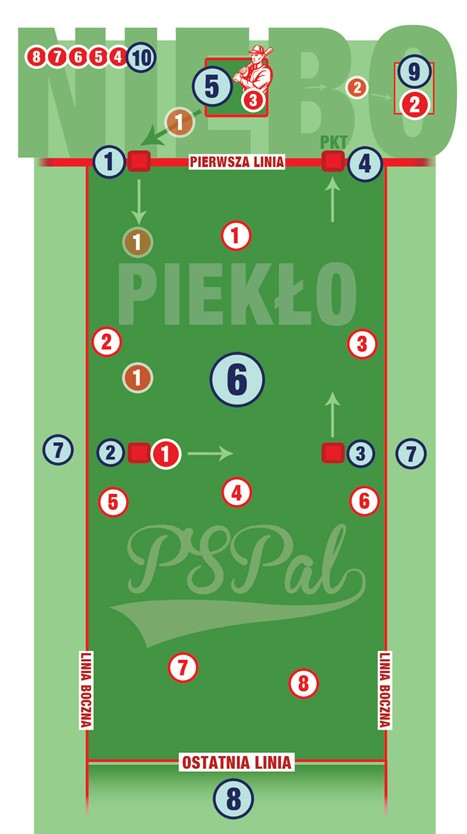
Source: Polish Palant Association: https://www.palantpowraca.pl/BASE NO.1
We start the game here. A maximum of 2 people can stand here. A third person from the same team, standing here, means an automatic switch of sides between teams.
BASE NO. 2
BASE NO.3
BASE NO. 4
We end the game here. Upon getting to this base, the player scores a point.
5 HITTING FIELD
The attacking player stands here, holds the bat with one hand, tossesthe ball with the other hand and hits it with a bat into the Catching Zone ( “Piekło”, eng.“Hell”). Every player has 3 attempts. You can use all of them, but you don't have to do that.
6 CATCHING ZONE (“PIEKŁO” (“HELL”))
In this area, the hitting players try to reach bases and the defending team (catchers) try to stop them, by catching the hit ball and throwing back to the zone, called “Niebo” (eng. “Heaven”, see the chart), throwing the ball at the running runners (only these ones who are not touching the bases in this moment) or catching the ball (preferably) with one hand.
7 SIDE FIELD (OUT)
• if the first contact of the ball is in this area after the hit –this ball is incorrect,
• but when the first contact of the ball after the hit is in the Catching Zone and the next hit is in the Side Field, we keep playing – the ball is correct.
8 ZAPOLE (“HEDGING”)
Perfect hitting the ball – it landed beyond the last line! The game is stopped! All players, situated at the bases, go to base 4. It is called “zapłot” if the ball is beyond the last line and between the side lines.
9 A FIELD FOR ELIMNATED PLAYERS
10 QUEUE OF IMPRESSION
Determined before the start of the run. The player can do maximum of 2 runs, i.e. to get 2 points. The second turn depends on the order in which you reach the Base no. 4.
+ BASE NO. 3 (blue) TEAM IS PICKING (SCORING POINTS)
+ BASE NO. 3 (red) TEAM IS CATCHING (DEFENDING THE SCORING POINTS)Running of the game:
Team of “Heaven” is placed in front of the “Heaven” line and team of “hell” is placed on the field.
The hitting team (“Heaven”) tries to keep as long as possible the “Heaven” field. To do so, their players are hitting the ball with the bat as far as possible and afterwards they runto reach another bases (from no. 1 to no. 4). Each time you reach a base no. 4, you get one point.
The team in the field of “hell” aims to conquer “Heaven”. To this end, they try to catch the hit ball in their hands as soon as possible and throw it back to the “Heaven” field or to hit the player who is running to reach the bases to stop as many players as possible.
If the defending player catches the ball with one hand, it is a fault and the batsman is out, he/she can no longer bat. If there is a catch in two hands or a foul in one hand, the game continues.When to switch sides?
Teams switch sides when:
• The attacking team commits 3 mistakes, e.g.:- a player, who is running to reach to the bases, is hit with the ball by defending players – this player is eliminated,
- one-handed catch (in Polish “Kampa” or “Chytek”) by one of the defending players– result: elimination of the attacking player,
- no proper hitting the ball by an attacking player in 3 attempts – he is not eliminated, but he/she goes to the first base.
• There are more than 2 people in the base no. 1.
• There are no players left in the attacking team to hit the ball.Ending of the game:
The game ends after the predetermined number of rounds (1 to 7). The winner is the team with more points earned for reaching to the base no. 4. - Current status:
Palant, as a well-deserved, traditional Polish sport, has not disappeared for good. One of the most interesting places where its traditions have been preserved, in an interesting local form, is Grabów near Łęczyca (Łódź Province) - more about this feast can be find here: https://inspirowanysportem.pl/palant-i-jego-historia/ (this is in Polish but it can be easily translated with the help of online tools).
In 2014, the Polish Palant Association (Polskie Stowarzyszenie Palantowe (PSPal)) was created in Warsaw, which aims to recreate the game of Palant, by promoting it, educating and training the young generation of Palant players, restoring classes in schools, organizing competitions and trainings in this sport, establishing and cooperating with other Palant associations in Poland and abroad etc.
For this purpose, Polish Palant Association organizes, among others, international tournaments in Palant and promotes this traditional Polish sport in the media. Thanks to these activities, this sport is once again more and more known at the local, national and even international level.
An interesting initiative of the Association in this context is the action Palant powraca (Palant returns) – organizing open trainings, matches and demonstrations of the game in various places in Poland and inviting famous people from the world of sports, television, show business, etc. to participate in them. They also organize, among others, Polish Champions every year, The Polish Cup and many such events.
The Palant ball club was also established in a town of Cyprzanów just after the first world war.
Palant is also played, among others, in a city of Lublin. Since 2008, numerous initiatives have been organized here, related to the promotion of this sport, as well as other Polish traditional sports.
Paland is also played in Słubice. The team from this town has won Polish Championships. They organize trainings very week. - Importance (for practitioners, communities etc.):
Palant has been a Polish traditional sport since at least 500 years. It was the most popular Polish sport before the second world war. There were regular competitions in this game. It was
a part of school physical education and was regularly played by people in their free time. After the above-mentioned criticism of the press and some academics, its popularity has significantly decreased. However, thanks to the above-mentioned activities of, among others, Polish Palant Association, this Polish, traditional sport is returning and regaining its popularity. It is again treated as an important part of Polish national and cultural heritage. Thanks to numerous initiatives, it has a chance to be again a Polish national sport – and not only sport, but an element of Polish culture. - Contacts:
Polskie Stowarzyszenie Palantowe (Polish Palant Association
Tel. 608 404 030This email address is being protected from spambots. You need JavaScript enabled to view it.
Web: www.palantpowraca.pl
Fb: https://www.facebook.com/Palant/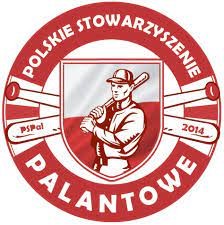
- Sources of information :
Video:
https://www.youtube.com/watch?v=xLVUfRyYDZ8
https://www.youtube.com/watch?v=ej_E776zKjsSource of photos used in this article and gallery: Polish Palant Association, www.palantpowraca.pl
- Gallery:

